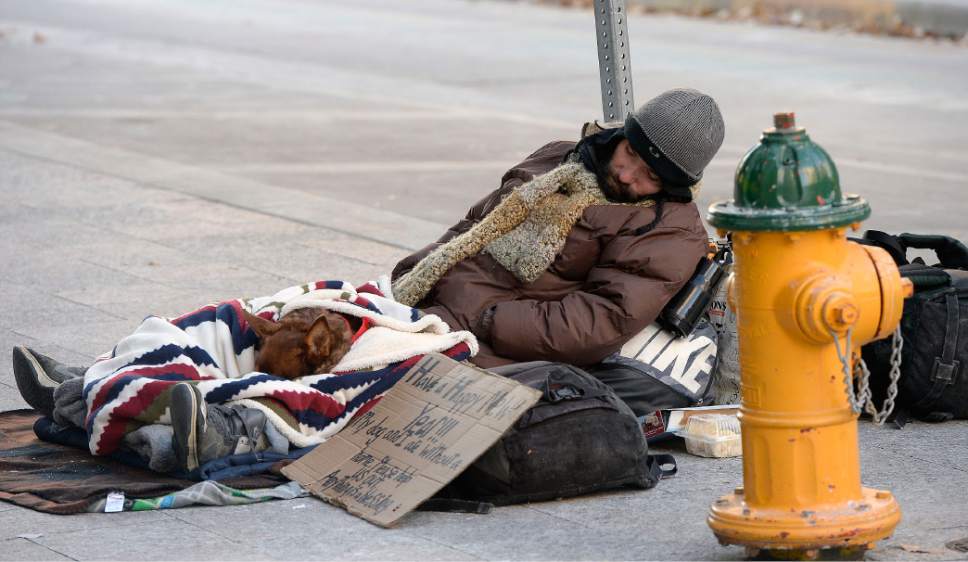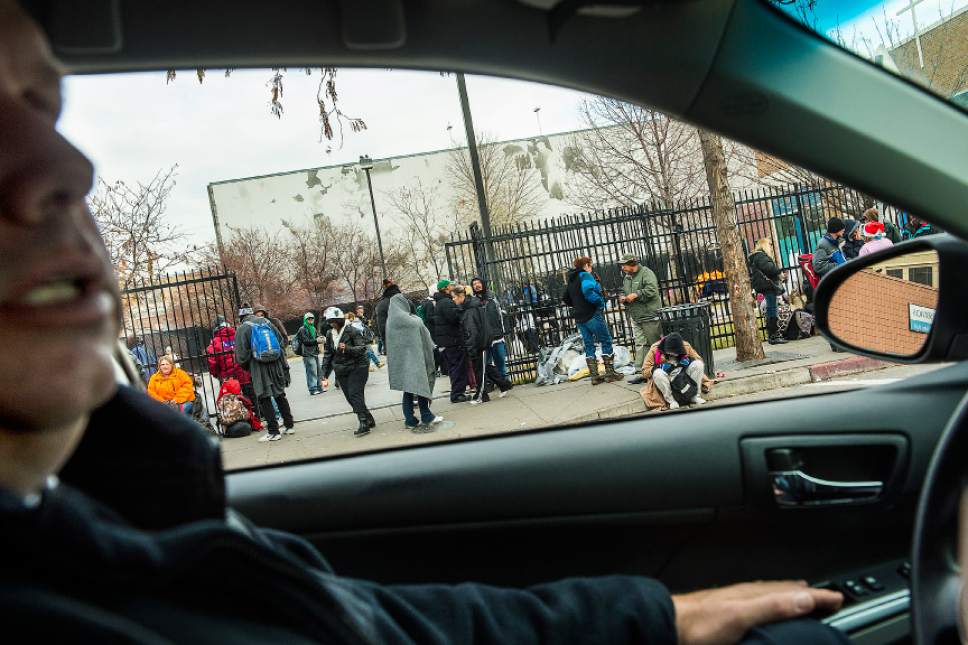This is an archived article that was published on sltrib.com in 2016, and information in the article may be outdated. It is provided only for personal research purposes and may not be reprinted.
To understand the new model for homeless shelters coming to Salt Lake City, you have to wipe clean the image of the chaos on Rio Grande Street downtown surrounding The Road Home.
At least that's the message from city and county leaders, who last week announced the sites of four future 150-bed homeless shelters/resource centers in the capital city.
The news provoked outrage from many residents in the Sugar House area near 653 E. Simpson Ave. (2300 South), where one of the resource centers is planned. Neighbors picture the danger and drug dealing on Rio Grande moving into their neighborhoods.
But city and Salt Lake County officials are quick to point to the YWCA shelter at 322 E. 300 South that houses up to 200 women and children. Casual passers-by don't recognize it as a shelter. There aren't any miscreants hanging about, it blends seamlessly into its surroundings and property values are said to be increasing.
Still, a lot of questions remain. And city and county leaders agree there are challenges ahead. But they stress the new strategy targets people's needs rather than simply counting heads and beds.
—
Housing and services • The new approach will be aimed at keeping people in housing or, at the very least, moving them in and out of shelters quickly, said Shaleane Gee, who heads up the Collective Impact initiative for Salt Lake County.
For the past two years, the effort, led by County Mayor Ben McAdams, has sought to coordinate disparate homeless-service providers into a holistic system that is easily accessed at any location by the homeless and those who fear they could become homeless.
That stands in contrast to the present array of service providers that came about organically as individual entities sought to aid the homeless. Although they all cooperate, there never has been an overarching system of coordination.
The new model is at least two years away from reality, officials say. Until then, residents and businesses near the planned sites may continue to fear the worst.
But Gee explained that the new shelter/resource centers are planned to avoid all the pitfalls of the scene around The Road Home on Rio Grande Street. That facility is slated to be downsized and ultimately closed after the new centers open.
Clients of the new shelters will not be hanging around outdoors waiting for a bed, as they do now downtown, Gee said. In addition, they will get services inside the facilities or be referred to providers elsewhere.
Meals will be served inside the facilities to clients, not all comers as at the St. Vincent de Paul Dining Hall across the street from The Road Home. And, Gee said, inner courtyards will allow clients to get fresh air without being preyed upon by drug dealers. Potential clients who suffer from mental illness, addiction or other serious maladies will be referred to facilities that specialize in those areas, rather than be housed in the centers.
"Shelters should be a place where people are moving through — a temporary place — and then they go elsewhere," Gee said. "These resource centers are designed to connect them to services and get them into housing as soon as possible."
—
Risks and challenges • Some observers, however, wonder about the numbers of homeless people — not only in the shelter but also sleeping on the streets — and how the planned scenario pencils out.
Bill Tibbitts of the Crossroads Urban Center, a nonprofit that assists low-income Utahns, sees a risk that more people may be on the street when the new shelters open and The Road Home closes.
The Rio Grande Street shelter can house up to 1,100. The combined beds in the planned centers will hold 600.
"If you reduce shelter space before you reduce demand, you'll have more people camping out," he said. "I'd rather the money be spent on keeping people from becoming homeless."
Although McAdams has said the new resource-center model will render unnecessary the need for The Road Home, he also explained the place wouldn't be shuttered if demand remains too high for the smaller facilities to meet.
The Utah Legislature allocated $9.2 million earlier this year for the new scheme, called the scattered-site model. Advocates say similar funding should be forthcoming in 2017 and 2018.
Nonetheless, financing for services appears to be a challenge.
Tibbitts said the proposal for increased caseworkers associated with the new model will require more money. Further, increased costs for mental health and addiction treatment will add to the overall tab. It remains unclear, he said, how much more that will cost and where those funds will come from.
"You can't have a plan without a budget," he said, otherwise "it feels like George W. Bush landing on an aircraft carrier, declaring, 'Mission accomplished.' "
Not least, Tibbitts said, the planned system hasn't been tested, and the rosy picture painted by some advocates is troubling.
"What they are saying is, 'We are going to try something that hasn't been tried before,' " he said. " 'Don't worry about the details, we'll figure things out.' "
—
Housing is key • Various aspects of the new model have been tried with success in other cities, Gee said. Integrating all the services into one system, however, may be novel.
The advantage to the new model is that all clients can be tracked to determine the success rates of all services offered. It will be a data-driven system that will instruct providers how best to serve.
Funding will remain a challenge, Gee said, as will available low-income housing.
Although moving people into housing is the focus of the new model, it butts up against the reality that housing is at a premium.
There is a 2 percent to 3 percent vacancy rate in Salt Lake City, meaning housing is scarce. And the lack of housing drives up rents. There is a dearth of 7,500 affordable housing units in Salt Lake City, according to official estimates. Countywide that number is 43,000.
Both the Salt Lake City Housing Authority and the Salt Lake County Housing Authority have projects underway that could be completed by the time the resource centers open.
Nonetheless, providing housing for everyone is going to be "a heavy lift," said Salt Lake City Councilman Derek Kitchen, whose District 4 encompasses The Road Home. That district also includes the planned sites at 648 W. 100 South and 131 E. 700 South.
"The City Council is moving to aggressively address that [housing] need with the allocation of $21 million this past October," Kitchen said in a Facebook post. "We are almost finished with our citywide housing plan that includes specific tools to fill the gaps."
—
Public relations • It's clear that city and county leaders have a lot of work to do to sell the plan to residents, particularly near the 653 E. Simpson Ave. site in Sugar House.
Emily Pennock, who lives nearby, said in response to a reader survey by The Salt Lake Tribune, in partnership with American Public Media's Public Insight Network, that the new model doesn't look like it will succeed.
"I would be willing to give the plan a chance if I thought it would work," she said. "I believe these centers are inadequate to solve the problem of homelessness, but will simply diffuse the issue from Rio Grande to these four areas."
With the coming of a resource center to Simpson Avenue, Pennock said, she no longer will be comfortable outside her house. She fears she won't be able to enjoy her neighborhood or even her own yard and outdoor furniture. Not least, she's worried her property's value will tank.
"My young family has only been in our home for 18 months. I had hoped to grow old in our beautiful little house," she said. "The charming atmosphere that residents love will be gone. We'll be just like the other undesirable neighborhoods, and there's nothing we can do."
The first casualty of the site announcements, after closed-door decision-making, is Pennock's trust in local government.
"This is a transparent ploy on the city's part to appease commerce at the expense of residents," she said. "If this had been open to discussion instead of being forced down our throats, I would have urged the City Council to add more services and more beds, not fewer."
The selection of the four sites is said to be final. But the council and Mayor Jackie Biskupski have yet to ratify the resolution officially naming them. Also to be determined is which demographic of the homeless population will be located at each site. Some council members are pushing for a women-only shelter on Simpson Avenue.





